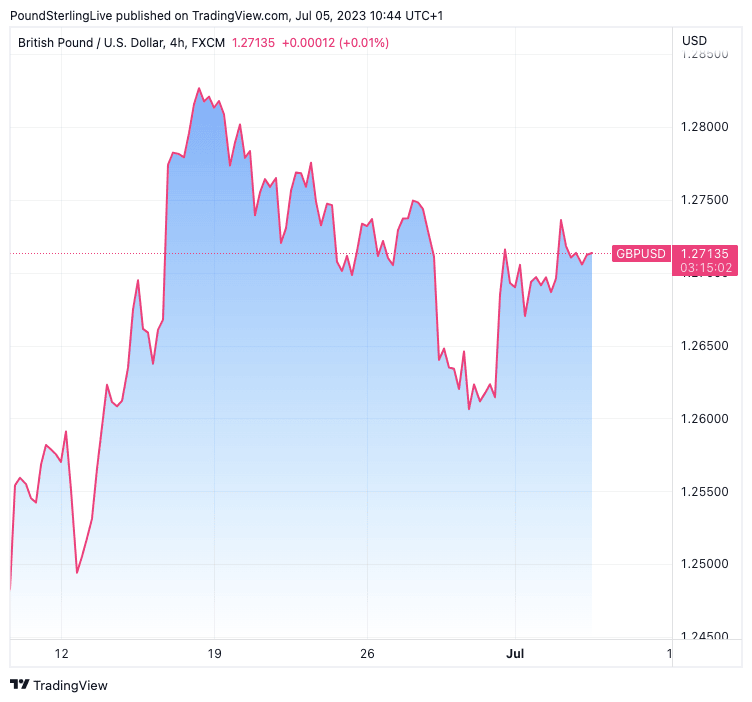Dollar Stays on Back Foot, Awaits More Key Data says XM.com

Above: The Pound to Dollar exchange rate at daily intervals.
The Pound to Dollar exchange rate has edged higher over recent days and the near-term direction here will reside with developments on the USD side of the equation, writes Charalampos Pissouros, Senior Investment Analyst at XM.com.
The U.S. dollar traded lower against most of the other major currencies on Tuesday, gaining ground only against the euro and the Swiss franc.
With the US markets being closed in celebration of Independence Day on Tuesday and thereby no economic releases on the agenda, traders may have maintained their short positions following Monday's disappointing ISM manufacturing PMI for June.
However, the letdown was not reflected in Treasury yields nor in market expectations about the Fed’s future course of action. Investors are still expecting slightly more than 30bps worth of additional rate increases and a series of rate reductions through 2024.
With that in mind, traders may pay extra attention to any incoming information that could help them better assess where interest rates may be headed. The next piece of such information may be the minutes of the June FOMC decision.
Nonetheless, with officials’ views already reflected in the dot plot and Fed Chair Jerome Powell speaking several times since then, the minutes are unlikely to result in any fireworks.
Ergo, any volatile swings in the dollar today are doubtful.
Investors may prefer to wait for the ADP and ISM non-manufacturing PMI tomorrow, ahead of Friday’s non-farm payrolls.
Following the larger-than-expected slides in both the prices and employment subindices of the ISM manufacturing PMI, investors may be looking for confirmation as to whether price pressures continue to cool at a fast pace and whether the labour market is indeed softening.
If upcoming data indeed suggest that, traders may scale back some basis points worth of expected hikes, and perhaps increase their cut bets for next year, which could hurt the US dollar.
The opposite may be true if the data come in better than expected.
The yen was also among the gainers against the US dollar yesterday, perhaps as some traders reduced their dollar/yen long positions near the psychological zone of 145.00 on fears of potential intervention.
Only yesterday, Japan’s top financial diplomat Masato Kanda said that they are in close contact with US Treasury Secretary Janet Yellen and other overseas officials "almost every day", which adds more credence to traders’ fears and could thereby result in some further liquidation or hedging of short-yen positions.
That said, given that Japanese authorities said they are watching the pace, rather than the level, in the yen decline, a careful and slow breach of the 145.00 zone in dollar/yen may not ring alarm bells just yet. Finance Minister Suzuki confirmed that Japan and the US are in close contact, but he avoided using comments he used just before last year’s intervention, like “deeply concerned about weak yen.” Thus, even if dollar/yen breaks above 145.00, as long as the pace of the decline is slow, an intervention episode may temporarily be avoided.
Wall Street resumes trading today after staying closed on Tuesday for the Independence Day celebrations. The latest piece of important risk-sentiment related information that hit the wires before the holiday was that China will apply controls on exports of some metals used in the semiconductor industry.
The move follows warnings from the US that they are considering new restrictions on chip exports to China. Although stocks were not affected by the headlines, given that the latest uptrend in Wall Street is tech driven, further uncertainty regarding the semiconductor industry could result in a pullback.
Nevertheless, even if there is a decline, it could be considered as a correction rather than the beginning of a bear market. With growth in the tech sector expected to accelerate in the years ahead, a potential risk-aversion episode could prompt investors to diversify their exposure from chipmakers like Nvidia to other more established tech stocks that are considered to be more defensive, like Alphabet, Apple, Meta, and Microsoft.

